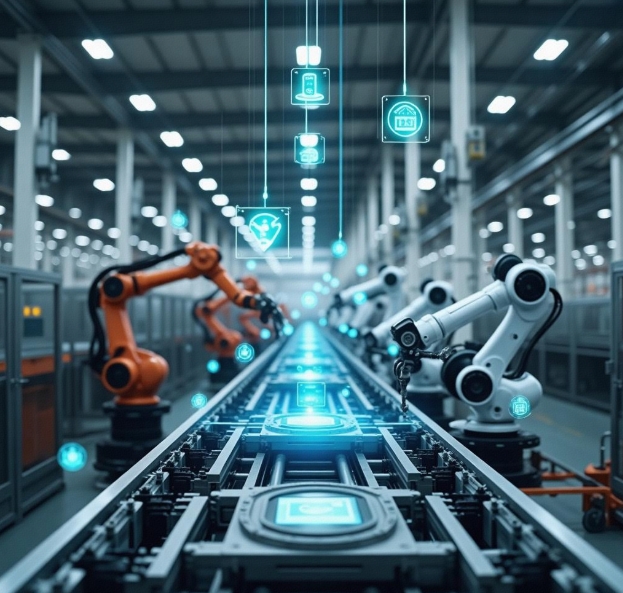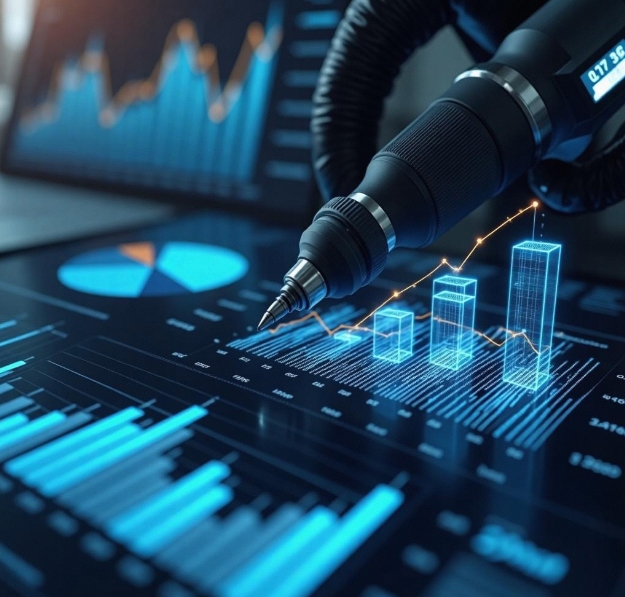The Integration of Artificial Intelligence and the Internet of Things: Unlocking an Intelligent Future
- latest articles
- 1.DApp Development & Customization: Merging Diverse Market Needs with User Experience 2.Analysis of the Core Technical System in DApp Project Development 3.How to achieve cross-chain interoperability in Web3 projects? 4.How does the tokenization of points reconstruct the e-commerce ecosystem? 5.How to Set and Track Data Metrics for a Points Mall? 6.What is DApp Development? Core Concepts and Technical Analysis 7.Inventory of commonly used Web3 development tools and usage tips 8.Development of a Distribution System Integrated with Social E-commerce 9.Six Key Steps for Businesses to Build a Points Mall System 10.What is DApp Development? A Comprehensive Guide from Concept to Implementation
- Popular Articles
- 1.Future Trends and Technology Predictions for APP Development in 2025 2.Analysis of the DeFi Ecosystem: How Developers Can Participate in Decentralized Finance Innovation 3.From Zero to One: How PI Mall Revolutionizes the Traditional E-commerce Model 4.DAPP Development | Best Practices for Professional Customization and Rapid Launch 5.Recommended by the Web3 developer community: the most noteworthy forums and resources 6.From Cloud Computing to Computing Power Leasing: Building a Flexible and Scalable Computing Resource Platform 7.How to Develop a Successful Douyin Mini Program: Technical Architecture and Best Practices 8.Shared Bike System APP: The Convenient Choice in the Era of Smart Travel 9.How to Create a Successful Dating App: From Needs Analysis to User Experience Design 10.From Design to Development: The Complete Process of Bringing an APP Idea to Life
In today's era of rapid technological advancement, the integration of Artificial Intelligence (AI) and the Internet of Things (IoT) has become a key force transforming the world. This cross-domain integration not only brings unprecedented innovation opportunities to industries and society but also drives the intelligentization process forward, opening the door to a smart future.
I. Basic Concepts of Artificial Intelligence and the Internet of Things
Artificial Intelligence (AI)
Artificial Intelligence refers to enabling machines to simulate human intelligence, including functions such as learning, reasoning, perception, and decision-making. It can analyze vast amounts of data to extract valuable information for automated decision-making and prediction. In recent years, with the development of technologies like deep learning and natural language processing, AI applications have expanded to cover fields such as healthcare, finance, manufacturing, and retail.
Internet of Things (IoT)
The Internet of Things is a technology that connects the physical world with the digital world through various sensing devices (such as sensors, cameras, etc.). Through networks, these devices can communicate with each other, exchange data, and thereby support intelligent management and decision-making. The core of IoT lies in "data," which comes from various sensors, terminals, and devices worldwide, enabling functions like remote control, real-time monitoring, and early warnings.
II. Background of AI and IoT Integration
With the continuous advancement of technologies like 5G, cloud computing, and big data, the integration of AI and IoT has become a significant driving force for the development of the intelligent era. The combination of AI's intelligent analysis and IoT's data collection can create smarter, more automated systems. This integration not only transforms industrial structures but also profoundly impacts people's lifestyles.
In this integration process, IoT provides AI with rich data sources, while AI uses its powerful algorithmic capabilities to intelligently analyze this data, enabling understanding and optimization of complex scenarios. IoT's data collection and processing capabilities make AI's reasoning and decision-making more precise, while AI's intelligence makes IoT devices more efficient and automated.

III. Application Scenarios of AI and IoT Integration
Smart Homes: Building Comfortable and Secure Living Environments
With the deep integration of AI and IoT, smart homes are gradually becoming part of people's lives. Various smart devices in the home (such as smart speakers, smart lighting, smart air conditioners, etc.) can interconnect through IoT and be intelligently controlled by AI. For example, smart air conditioners can automatically adjust the temperature based on user habits and environmental changes, while smart speakers can control other smart home devices according to user commands, providing a more personalized and convenient user experience.
Smart Cities: Enhancing Urban Management Efficiency
The construction of smart cities relies on the combination of AI and IoT. Through IoT technology, various urban infrastructures (such as transportation, energy, water supply, environmental monitoring, etc.) can achieve real-time monitoring and remote control. Meanwhile, AI applications can analyze this massive data to predict traffic flow, optimize energy distribution, monitor environmental pollution, etc., thereby improving urban operational efficiency and residents' quality of life.
For example, smart transportation systems use IoT devices to collect real-time data on vehicles on the road, analyze traffic flow, road conditions, weather, and other information through AI, automatically adjust traffic signals to reduce congestion, and enhance traffic efficiency. Similarly, IoT sensors can monitor urban air quality in real-time, and AI can analyze the data to identify pollution sources and propose corresponding governance solutions.
Smart Healthcare: Improving Health Management
In the healthcare field, the integration of AI and IoT is driving the intelligentization of medical and health management. Through IoT devices, doctors can monitor patients' health status (such as blood sugar, blood pressure, heart rate, etc.) in real-time and use AI technology to analyze patients' health data, predict disease risks, and propose personalized treatment plans.
Smart wearable devices like smart bands and smartwatches can collect users' physiological data in real-time and transmit it to the cloud for analysis by AI. This not only helps users understand their health status in real-time but also provides medical institutions with more accurate medical record information, assisting doctors in making more scientific diagnostic and treatment decisions.
Industry 4.0: Achieving Intelligent Transformation in Manufacturing
In the industrial sector, the integration of AI and IoT is driving the intelligent transformation of manufacturing. Through sensors and IoT devices, factories can monitor production line operations in real-time, promptly identifying issues such as equipment failures and production bottlenecks. AI technology can analyze large amounts of production data to optimize production processes, improve efficiency, reduce resource waste, and even achieve intelligent prediction and fault warnings.
Additionally, the combination of AI and IoT can promote product intelligence. For example, smart robots can perform complex assembly tasks on production lines and possess self-learning and adaptive capabilities. This not only reduces production costs but also improves product quality and production flexibility.
IV. Challenges in AI and IoT Integration
Although the integration of AI and IoT brings enormous potential to various industries, it still faces some challenges in practical applications:
Data Privacy and Security Issues
Data generated by IoT devices often involves users' personal information and enterprises' sensitive data, making data privacy and security an urgent issue to address. When processing this data, AI must ensure data confidentiality and integrity to prevent data leaks and malicious attacks.
Unification of Technical Standards
Currently, technical standards for IoT and AI are not fully unified. Differences in data formats, protocols, interfaces, etc., among different manufacturers and platforms create difficulties in device interoperability. To achieve better collaboration, all parties need to jointly promote the unification and improvement of technical standards.
Cost and Technical Barriers
Although the integration of AI and IoT brings many innovation opportunities, enterprises need to invest significant financial and technical resources in practical applications. For some small and medium-sized enterprises, high costs and technical barriers may hinder the promotion of intelligent applications.

V. Future Outlook
The integration of AI and IoT will continue to accelerate, especially with the push of 5G technology, enabling IoT devices to achieve faster and more stable data transmission, further enhancing the efficiency and experience of intelligent applications. In the future, with the continuous optimization of AI algorithms and the widespread adoption of IoT devices, the integration of AI and IoT will become even more ubiquitous, serving as a vital force driving social progress and industrial transformation.
For example, in future smart cities, the combination of AI and IoT will not only be reflected in traffic management and urban infrastructure but will also extend to environmental protection, public safety, energy management, and other areas, building a smarter, greener, and more livable urban environment. In the healthcare field, the integration of AI and IoT will greatly enhance the efficiency of global medical resource utilization, safeguarding human health.
Conclusion
The integration of AI and IoT is changing our world at an astonishing pace. From smart homes to smart cities, from industrial manufacturing to smart healthcare, the combination of AI and IoT will be everywhere, bringing us smarter, more automated, and more convenient ways of living and working. Although facing challenges such as technology and data privacy, with continuous technological development and improvement, the future intelligent world is within reach.
Through continuous exploration and innovation, the integration of AI and IoT is bound to unleash immense potential in the future, creating a better tomorrow for humanity.
-

How does artificial intelligence technology transform the operational models of modern enterprises?
In the wave of the digital era, artificial intelligence (AI) technology has tran···
-

How to Utilize Artificial Intelligence for Precision Medicine and Health Management
With the rapid advancement of technology, artificial intelligence (AI) has demon···
-

Integration and Application of Artificial Intelligence and Robotics
In today's era of rapid technological advancement, the integration of artificial···

 Blockchain
Blockchain










